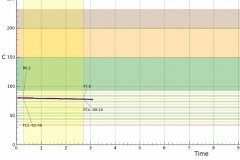Boutique Coffee Learning Al Rule Sweet Point Formula
Al Critzer's understanding of Espresso extraction has become the most common concept of Espresso in Europe and the United States.

The translation is as follows:
Start with the result that 30cc/ 30sec gets a perfect Espresso. These two values of course depend on beans, and the differences in baking method, baking degree and formula ratio will naturally lead to changes in the reference point.
The amount of extraction is inversely proportional to the extraction time.
The more the amount of extraction, the shorter the time for coffee powder to come into contact with hot water (to avoid excessive extraction).
On the contrary, when the amount of extraction is reduced, the contact time between coffee powder and water should be increased (to avoid insufficient extraction).
Al formula: when the extraction amount of 5cc is increased, the extraction time should be subtracted from 1sec. On the contrary, add 1sec.
For example, when the amount of extraction increases to 45cc, 30-(45-30) / 527, the extraction time is reduced to 27sec.
When the extraction amount is 60cc, the extraction time becomes 24sec.
Within the reasonable limit of Espresso of 0.75-2.5oz, this formula can quickly and correctly hunt sweet spots (Sweet Spot), effectively catch satisfactory ingredients, and maintain the balance between over-extraction and under-extraction. The main means of control is to adjust the grinding thickness.
In addition, Al Critzer also explained the definition of Ristretto:
Ristretto is a very different drink from normal espresso.
If the grinding is constant and the extraction is finished early at the normal espresso flow rate, for example, at the original 30sec/ 30cc flow rate, only 25cc is taken, which is the result of insufficient cup extraction because it has not yet reached the sweet point (Sweet Spot).
The so-called ristretto is defined as restricted, and the customary practice is 25cc/ 30-35sec.
All sensory sensations, including what the eyes see, what the nose smells, and what the tongue tastes, whether it's good or bad, are aggravated.
Ristretto is characterized by a particularly thin mouse tail and a darker brown crema, so it has to be adjusted by grinding.
Important Notice :
前街咖啡 FrontStreet Coffee has moved to new addredd:
FrontStreet Coffee Address: 315,Donghua East Road,GuangZhou
Tel:020 38364473
- Prev

Common sense of Coffee CENTER 301 thermometer measuring the change of Water temperature of hand Pot
The FCs in the picture is the water temperature in the hand pot during stewing. The FCe in the picture shows that the water temperature in the hand pot is stewed once after brewing, and the water is cut off for 3 times. It can be seen from the picture that the total time is 2 minutes and 27 seconds, the temperature drops from 80.2 to 77.8, and the temperature difference is 2.4 degrees. Conclusion: none, just for self-entertainment.
- Next

General knowledge of fine coffee brewing coffee in a siphon pot at home
Generally speaking. Siphon coffee will heat the siphon pot in two ways, one is gas, and the other is sprinkling essence. Because of its high firepower and relatively high heating, gas is used by more cafes. In fact, there is a big difference between the two heating methods. Step 1: select the appropriate thickness of ground beans. For siphon coffee, it is recommended that the thickness of ground beans is close to that of special grains and fine sand. So just buy one.
Related
- Beginners will see the "Coffee pull flower" guide!
- What is the difference between ice blog purified milk and ordinary milk coffee?
- Why is the Philippines the largest producer of crops in Liberia?
- For coffee extraction, should the fine powder be retained?
- How does extracted espresso fill pressed powder? How much strength does it take to press the powder?
- How to make jasmine cold extract coffee? Is the jasmine + latte good?
- Will this little toy really make the coffee taste better? How does Lily Drip affect coffee extraction?
- Will the action of slapping the filter cup also affect coffee extraction?
- What's the difference between powder-to-water ratio and powder-to-liquid ratio?
- What is the Ethiopian local species? What does it have to do with Heirloom native species?

